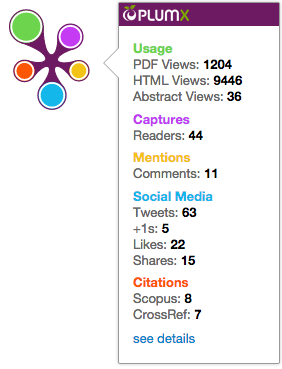Becker Model
The Becker Medical Library Model for Assessment of Research Impact is a model for tracking diffusion of research outputs and activities to locate indicators that demonstrate evidence of biomedical research impact.
Using the Becker Model in tandem with publication analysis provides a more robust and comprehensive perspective of biomedical research impact. The model also includes guidance for quantifying and documenting research impact as well as resources for locating evidence of impact.
The model is organized into five pathways:
- Advancement of Knowledge
- Clinical Implementation
- Community Benefit
- Legislation and Policy
- Economic Benefit
These pathways, along with indicators and examples, appear in the chart below.
Pathways, Indicators, and Evidence
Pathway #1: Advancement of Knowledge
Advancement of knowledge represents research outputs that contribute to the scholarly record.
| Indicators | Evidence |
| Cost Savings | Study findings resulted in reduced costs in the delivery of health care services |
| Quality of Healthcare Services | Study findings resulted in increased performance and quality in delivery of health care services |
| Morbidity and Mortality | Research findings resulted in reduction of disease burden, morbidity, mortality, or prevalence of a disease. |
| Start-up Company | Start-up company formed as a result of research study (cite: revenue generated, # of employees hired) |
Pathway #2: Clinical Implementation
Clinical implementation is the application or adoption of research outputs in clinical applications.
| Indicators | Evidence |
| Clinically Effective Practice | Clinicians report change in delivery of healthcare based on findings of study. |
| Coding | HCPCS/ICD/CPT code implemented as a result of research study. |
| Diagnostic Procedures | Study findings resulted in a diagnostic application or screening tool for a disease or condition. |
| Reporting Requirements | Study identifies new parameter leading to surveillance and reporting of a disease. |
Pathway #3: Community Benefit
Community benefit is the enhancement of well-being to the community as a result of research outputs.
| Indicators | Evidence |
| Consumer Health Information | Study findings resulted in patient decision materials to assist with healthcare decision-making, or are cited in materials for patients or the public. |
| Health Promotion | Study findings resulted in enhancement of health promotion activities among community members. |
| Partnerships | Study forms partnership with the community or other group. |
Pathway #4: Legislation and Policy
Legislation and policy represents codification of research outputs into public law, guidelines, standards, or policy.
| Indicators | Evidence |
| Committee Participation | Research study members invited to serve on advisory boards, or committees for policy development. |
| Guidelines | Research study cited in development of guidelines issued by an organization. |
| Policy | Research study cited in enactment of federal, state, or local policy. |
| Testimony/Witness | Testimony based on research outputs is presented before a legislative body. |
Pathway #5: Economic Benefit
Economic benefit represents economic outcomes as a result of research outputs.
| Indicators | Evidence |
| Cost Savings | Study findings resulted in reduced costs for the delivery of healthcare services. |
| Quality of Healthcare Services | Study findings resulted in increased performance and quality in delivery of healthcare services. |
| Morbidity and Mortality | Study findings resulted in reduction of disease burden, morbidity, mortality, or prevalence of a disease. |
| Start-up Company | Start-up company formed as a result of research study (cite: revenue generated, # of employees hired) |
PlumX Analytics
Plum Analytics is an Elsevier-owned product that provides author and article-level metrics. Institutional-level metrics are available under a separate subscription. Metrics are categorized into 5 types: Usage, Captures, Mentions, Social Media, and Citations.
The PlumX widget displays for results retrieved in Health Information @ Himmelfarb, the search box on the library homepage. Clicking on the widget to the left hand side of an article record will show you more details and metrics. The institutional repository Health Sciences Research Commons automatically includes PlumX metrics.

Examples of PlumX in Health Information @ Himmelfarb


Publons
Being selected to peer review a paper is indicative that you are considered an expert in your field. But many reviewers don't receive recognition for their work in this area because reviews are often discarded after articles are published. Get credit for your peer review activities through Publons, a network of more than 65,000 reviewers, editors, and authors that records and verifies researchers' peer review contributions.
You can link your ORCID with Publons to get credit for verified peer review activities. Here's how.




